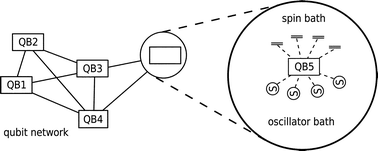Spin-based quantum computers made by chemistry: hows and whys†
Abstract
This introductory review discusses the main problems facing the attempt to build quantum information processing systems (like quantum computers) from spin-based qubits. We emphasize ‘bottom-up’ attempts using methods from chemistry. The essentials of quantum computing are explained, along with a description of the qubits and their interactions in terms of physical spin qubits. The main problem to be overcome in this whole field is decoherence—it must be considered in any design for qubits. We give an overview of how decoherence works, and then describe some of the practical ways to suppress contributions to decoherence from spin bath and oscillator bath environments, and from dipolar interactions. Dipolar interactions create special problems of their own because of their long range. Finally, taking into account the problems raised by decoherence, by dipolar interactions, and by architectural constraints, we discuss various strategies for making chemistry-based spin qubits, using both magnetic molecules and magnetic ions.

- This article is part of the themed collection: Molecular spintronics and quantum computing

 Please wait while we load your content...
Please wait while we load your content...